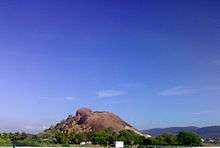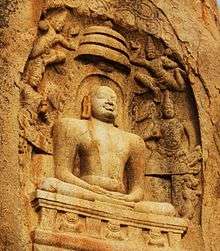Samanar Hills
| Samanar Malai | |
|---|---|
 Samanar Hills | |
| Basic information | |
| Location | Keelakuyilkudi village, Tamil Nadu |
| Affiliation | Jainism |
| Date established | 9th century |
Samanar Hills or Samanar Malai is a hill rock complex located in Keelakuyilkudi village, 15 kilometres (9.3 mi) from Madurai, Tamil Nadu, India.[1] The hill has been declared as a protected monument by the Archaeological Survey of India.[2][3]
Information
Samanar means Jain in Tamil and malai means hill. This hill has caves where Tamil Jain (Samanar) monks lived.[4] The hill was also known as Thiruvuruvagam.[5]
Samanar Malai has several Tamil-Brahmi inscriptions, a number of stone beds and many sculptures, which shows authority for Jainism in the ancient Tamil country.[6] The hill contains two famous sculptures, Settipodavu and Pechipallam, that show images of Jain Tirthankaras made by Jain monks in the 9th century BCE.[6] The Settipodavu contains the image of Mahavira, the last tirthankara of Jainism.[7] The Pechipallam contains eight sculptures, including Bahubali and Mahavira.[7]
Archaeologists have also found 2000-year-old Tamil-Brahmi inscriptions and Vatteluttu writings.[1] The inscriptions reveal that hundreds of Jain monks took sallekena (fast unto death) there.[8] There are flat rocks, called stone beds, used by the monks to take rest.[1]
The findings through the Tamil and Kannada inscriptions show that there was a Jain monastery at the top of the hill known as Maadevi Perumpalli.[9][5] The Maadevi Perumpalli was an educational academy in which both Jain monks and nuns studied. The kings from the Pandyan Dynasty, who ruled Madurai, visited the academy. The Kannada students and senior monks from Shravanabelagola also stayed there.[9][6]
In the foothills, there is a Karuppanasamy temple and lotus pond.[3] Some idols made by Jain monks are in Karuppanasamy temple. The caves in the hill have been damaged by illegal quarrying in the region.[10][3]
Gallery
 Pechipallam
Pechipallam Image of Vardhamana Mahavira, the 24th Tirthankara at Samanar Hills
Image of Vardhamana Mahavira, the 24th Tirthankara at Samanar Hills- Settipodavu
- Tirthanakar Sculpture
- Mahavira
References
- 1 2 3 T. S. Subramanian (24 March 2012). "2,200-year-old Tamil-Brahmi inscription found on Samanamalai". The Hindu. Retrieved 19 January 2014.
- ↑ "List of Centrally Protected Monuments – Tamil Nadu". Archaeological Survey of India. Retrieved 20 January 2014.
- 1 2 3 "Green hope amidst ruins". Frontline.in. 14 September 2013. Retrieved 19 January 2014.
- ↑ M. K. Chandrashekaran (1 January 2005). Time in the Living World. Universities Press. pp. 83–. ISBN 978-81-7371-546-4.
- 1 2 "Jainism – Madurai – Jain hill – Keelakuyilkudi". tamilnadonline.com. Retrieved 20 January 2014.
- 1 2 3 "Unearthing stories from stone". The Hindu. 6 January 2013. Retrieved 19 January 2014.
- 1 2 "Samanar Malai". Indian National Trust for Art and Cultural Heritage. Retrieved 19 January 2014.
- ↑ "Understanding Madurai". The Hindu. 28 March 2013. Retrieved 19 January 2014.
- 1 2 S. Aravindan (August 2008). "Heritage value of Perumal Malai" (pdf). Development Matters. Development of Humane Action. p. 15. Retrieved 20 January 2014.
- ↑ "Unexploited vestiges of Jainism". 25 April 2002. Retrieved 20 January 2014.
| Wikimedia Commons has media related to Samanar Malai. |
Coordinates: 09°55′22″N 78°02′50″E / 9.92278°N 78.04722°E